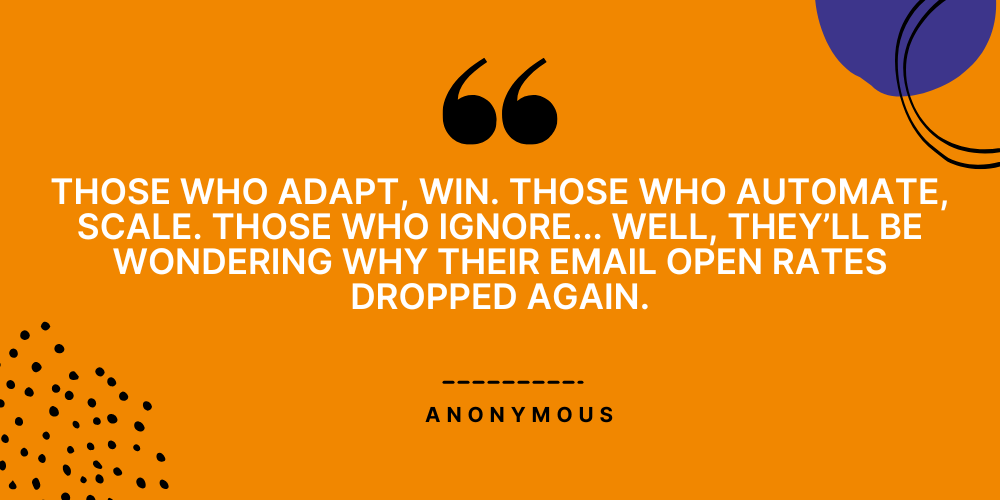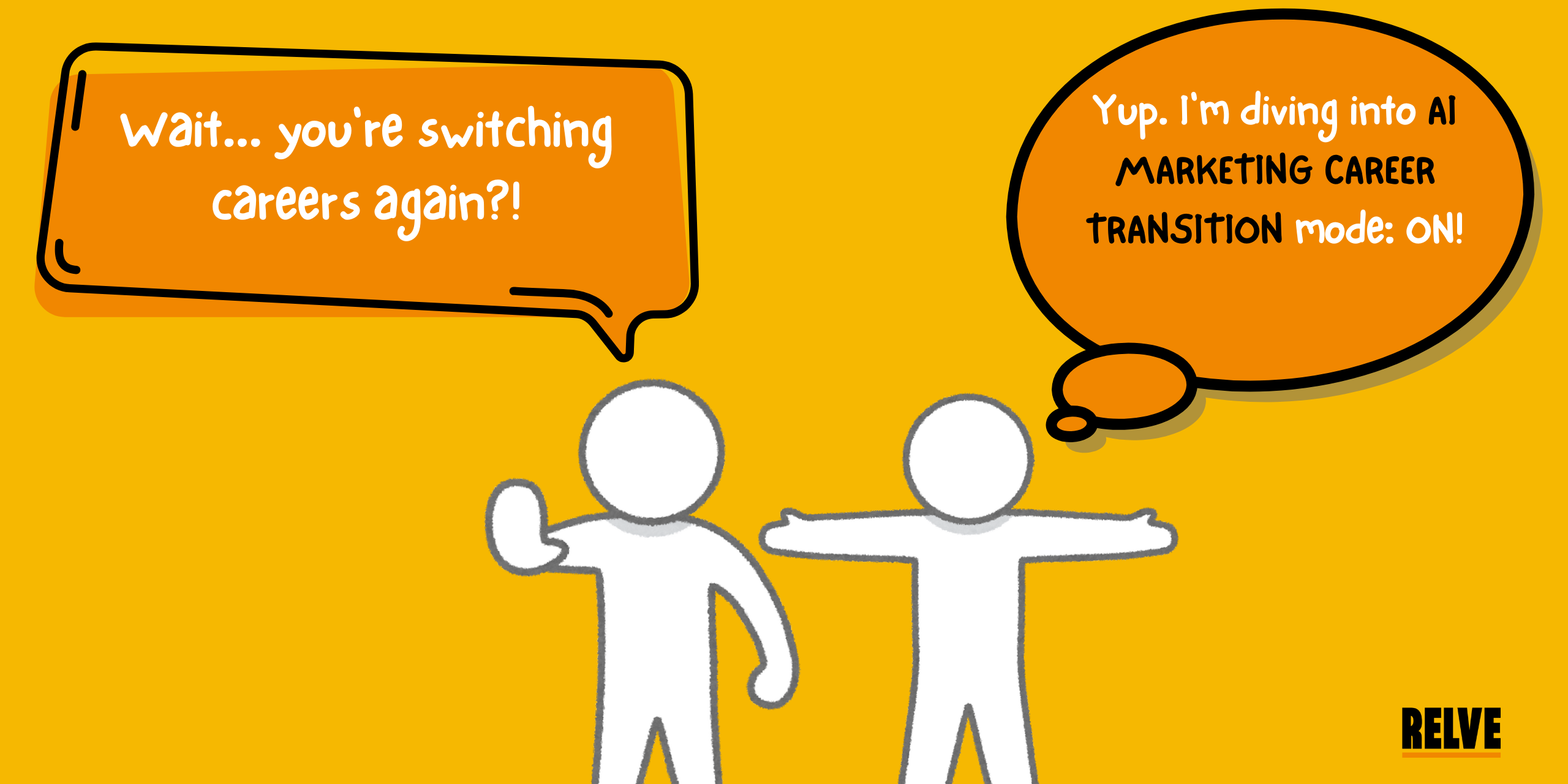You’re staring at yet another AI-generated ad copy draft, wondering if you’re still the strategist or just a glorified fact-checker on the team? Maybe you’ve noticed fewer briefs landing in your inbox, or your team just replaced three marketing interns with one well-prompted ChatGPT subscription. Sound familiar? If you’re navigating the uneasy middle ground between creative instinct and algorithmic efficiency, your AI marketing career transition has already begun. It’s also not too late to level up your skills.
Nearly 8 out of 10 marketers say AI enables them to work more efficiently and intelligently by simplifying data analysis, uncovering customer insights, and enhancing their overall marketing efforts.
This is your guide to making a confident AI marketing career transition – not just because the industry is evolving, but because you deserve to evolve with it.
Why Make an AI Marketing Career Transition Now?
Let’s be honest. The marketing landscape is more volatile than your caffeine-deprived Slack thread on deadline day. Traditional roles are evolving faster than Gen Z memes. So why now?
- Automation is exploding – from content creation to CRM workflows.
- New jobs are sprouting – and they need hybrid marketers who speak both Brand and Bot.
- Companies are hiring differently – they’re not just looking for marketers, they’re looking for AI-empowered strategists.
Instead of waiting for the bots to take over, let’s use them as tools to supercharge your job role.

What’s Changing with AI in Marketing Jobs Taking a Bigger Role
Here are some traditional tasks and how they have been enhanced by AI tools for marketing:
The Big “Why” Behind Every AI Marketing Career Transition
75% of marketers say they’re already using AI tools in their workflows. It’s easy to feel pressured into pivoting just because everyone else on LinkedIn is “AI-curious.”
Ask yourself:
- Are you stuck in repetitive marketing tasks that could be automated?
- Do you enjoy experimenting with tools and tech?
- Are you curious about what’s next in marketing?
If you answered “yes” to any of these (or all three for that matter), this guide is for you.
AI Marketing Job Roles and Responsibilities to Explore
The marketing world is being reshaped by artificial intelligence, giving rise to a new generation of hybrid roles that fuse creativity with technical prowess. Whether you’re a content nerd who dreams in storytelling frameworks or a data junkie who finds joy in dashboards and models, there’s an evolving AI marketing role tailor-made for your talents.
Here are 7 of the most in-demand roles where opportunities are skyrocketing:
1. AI-Powered Content Strategist
Content is still king, but now it is being powered by algorithms. The AI-powered content strategist blends classic storytelling with intelligent tools to scale content production without losing creativity. This role is ideal for marketers who love to write but aren’t afraid of a little machine assistance.
- Key Responsibilities: Uses AI tools to ideate, plan, and optimize high-performing content strategies. Combines SEO best practices, storytelling techniques, and automation workflows.
- Tools of the Trade: Jasper, Copy.ai, ChatGPT, SurferSEO.
2. AI Marketing Data Analyst
In this role, AI becomes your co-pilot in decoding customer behavior and campaign performance. Rather than crunching numbers manually, you’ll rely on models to predict trends, uncover insights, and drive smarter decisions. If data tells your favorite kind of story, this one’s for you.
- Key Responsibilities: Leverages AI and machine learning to uncover insights, predict ROI, and optimize campaigns. Specializes in audience segmentation, trend forecasting, and behavioural analytics.
- Tools of the Trade: Google Analytics 4, Tableau, Python, BigQuery.
3. SEO + NLP Specialist
Search is evolving – and so must SEO. This role is for those who understand the nuances of natural language processing and how AI is rewriting the rules of discoverability. It’s about creating content that speaks to both users and search algorithms.
- Key Responsibilities: Uses AI-driven tools to optimize content for semantic search, user intent, and SERP visibility. Stays ahead of evolving search engine algorithms influenced by NLP.
- Tools of the Trade: SurferSEO, Clearscope, ChatGPT, MarketMuse.
4. AI Automation Specialist
If you’re the type who hates repetitive tasks and loves efficiency, this role is your sweet spot. The AI Automation Specialist builds smart systems that connect the dots between tools, platforms, and processes. All with minimal human touch.
- Key Responsibilities: Designs and builds AI-driven workflows to reduce manual effort and enhance efficiency across the marketing funnel. Automates emails, lead scoring, segmentation, and reporting.
- Tools of the Trade: Zapier, HubSpot AI, Make (Integromat), ActiveCampaign.
5. AI Ad Buyer / Programmatic Specialist
Ad buying has gone from gut feelings to guided algorithms. This role uses AI to remove the guesswork from budget allocation and targeting. You’ll be maximizing return while letting machine learning models do the heavy lifting.
- Key Responsibilities: Automates and optimizes digital media buys using AI. Monitors campaign performance, applies predictive analytics, and adjusts ad spend in real time.
- Tools of the Trade: AdRoll, Skai, Meta Advantage+, Google Performance Max.
6. Conversational UX Designer
Chatbots and voice assistants are becoming the front lines of customer interaction. This role shapes those experiences, ensuring they’re helpful, human-sounding, and brand-aligned. Perfect for those who think like designers but write like storytellers.
- Key Responsibilities: Crafts user flows, conversational prompts, and chatbot personas using AI. Design interactions that feel natural while collecting data and solving problems.
- Tools of the Trade: Drift, Intercom, Voiceflow, Botpress.
7. AI Creative Technologist
At the intersection of code and creativity lies this unique role. AI Creative Technologists use cutting-edge generative tools to produce eye-catching visuals and immersive brand experiences. If you’re both an artist and an engineer, this is your playground.
- Key Responsibilities: Combines design instincts with technical tools to generate images, animations, and branded visuals using AI. Collaborates across creative and tech teams.
- Tools of the Trade: Midjourney, Adobe Firefly, Runway, DALL·E, Canva AI.
Bonus: These are all hybrid roles in AI marketing, which means your creative brain and technical curiosity finally get to sit at the same lunch table.
Are You Ready for an AI Marketing Career?
AI Marketing Career Transition Paths: Based on Your Background
Choose your path. Pick your superpower. Let’s tailor your transition.
Content Marketers:
- Learn prompt engineering (a.k.a. how to talk to machines without sounding like a caveman).
- Master AI-powered SEO (MarketMuse, Clearscope).
- Build a content system that publishes smarter, not harder.
Performance Marketers:
- Explore predictive modeling and AI-based attribution.
- Start with Google Ads Smart Bidding → move to Skai/AdRoll.
- Automate reporting dashboards using Looker Studio.
Brand Marketers:
- Study emotional AI and audience insights tools.
- Use AI to test creative variants faster and at scale.
Generalists:
- Get hands-on with Zapier + ChatGPT + Canva AI.
- Learn the stack first, specialize later.
Your 12-Month Career Transition Plan
Let’s not just learn. Let’s plot.
1–3: Foundation
- Take a crash course on AI basics (Google AI for Everyone, HubSpot’s AI Academy).
- Explore tools: Jasper, ChatGPT, SurferSEO, Zapier.
- Start using AI in one campaign task every week.
4–6: Deep Dive
- Build your AI-enhanced portfolio: case studies, before/after content, automation walkthroughs.
- Learn basic Python or Airtable formulas (no pressure).
7–12: Go Pro
- Pick a certification: IBM’s AI in Marketing, Coursera’s Marketing Analytics, or Drift’s Conversational Marketing.
- Apply to AI-forward roles or pitch internal transition projects.
- Build your personal brand on LinkedIn by sharing your learnings.
Your AI Marketing Career Transition Roadmap
Essential Skills for Every AI Marketing Role
Let’s break this down like a TikTok tutorial:
Hard Skills
- Prompt Engineering (Jasper, GPT-4)
- Predictive Analytics
- Marketing Automation Platforms
- No-code tools (Zapier, Airtable, Bubble)
Soft Skills
- Curiosity (be the “what if we tried…” person)
- Storytelling (AI helps, but can’t feel)
- Adaptability (you’ll be learning forever)
Core Marketing Skills
- Audience empathy
- Funnel design
- Testing frameworks
AI Marketing Tools You Should Start Using Yesterday
Here’s your Swiss Army knife:
- ChatGPT – Brainstorming, rewriting, automation
- Jasper – Long-form content
- Midjourney – Visuals and art direction
- SurferSEO – Content optimization
- Zapier – Automation workflows
- Notion AI – Productivity
- HubSpot AI – CRM and sales integration
- Looker Studio – AI-enhanced dashboards
You don’t need to master them all – just pick 2–3 and build from there.
Which AI Tool Should You Learn First?
Select your marketing goal and get an AI tool recommendation:
Final Thoughts: This is Your Moment
The rise of AI doesn’t spell the end of marketing jobs—it’s the evolution of them. Your goal isn’t to become a data scientist or robot whisperer. It’s to add AI to your existing skill set and become a more powerful, more employable marketer.
Whether you’re a creative, analyst, strategist, or all three on a bad day, this is your chance to pivot smartly into one of the most exciting revolutions in digital history.
Action Steps Before You Close This Tab
- Bookmark this page.
- Pick one AI tool and test it this week.
- Share your learnings on LinkedIn. Tag other marketers.
- Start treating your AI marketing career transition like your next big campaign—data-driven, audience-first, and a little bit chaotic (but fun).
